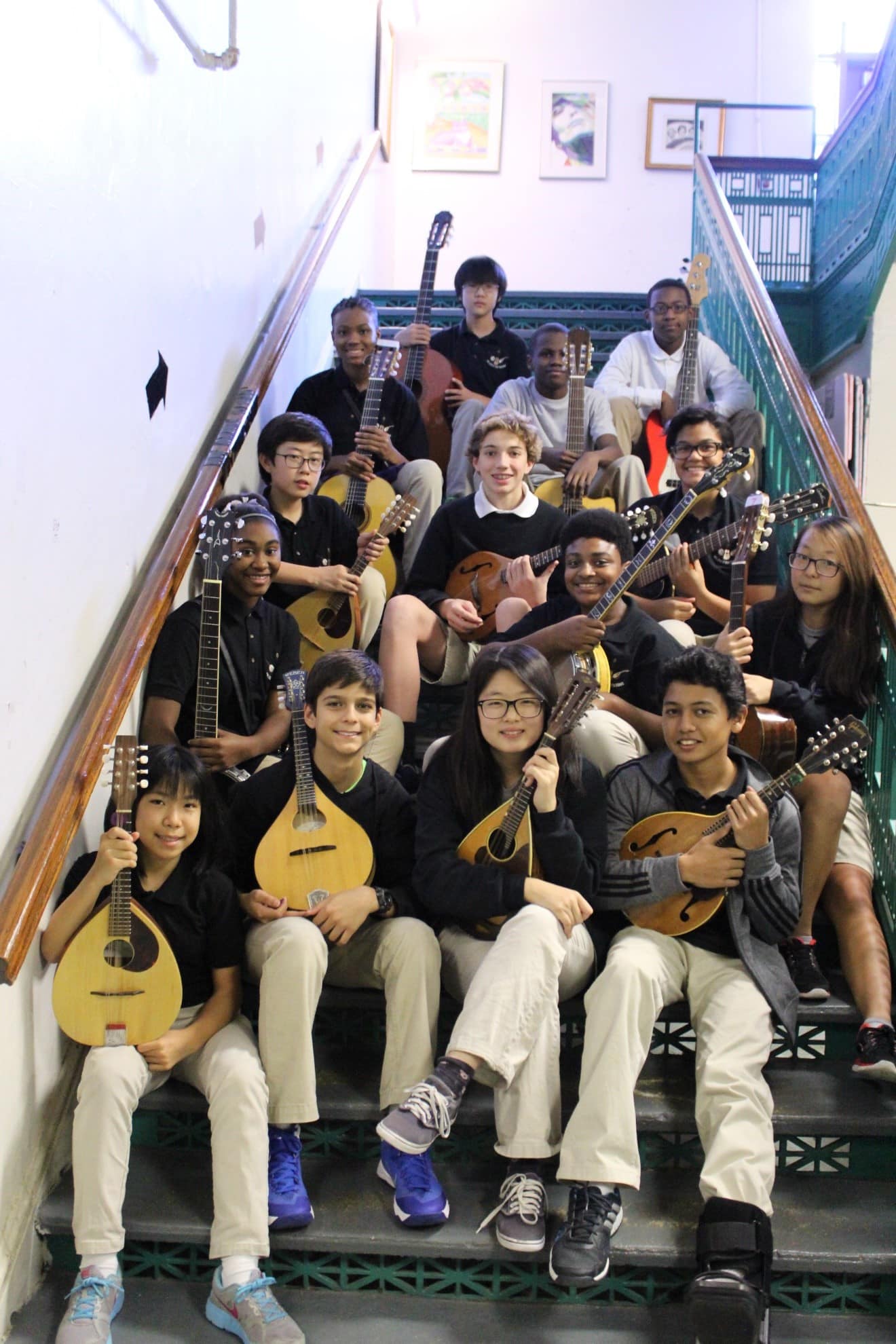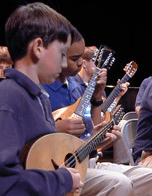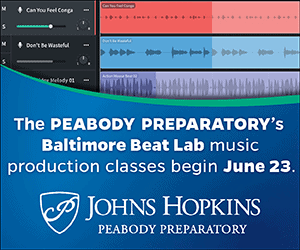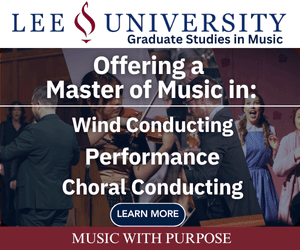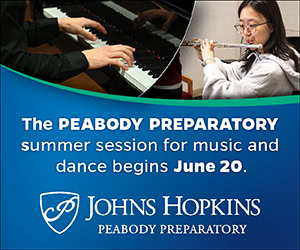/ News Posts / Guitar Class in the Yellowhammer State
Guitar Class in the Yellowhammer State
Number 22: The State of Alabama
By Thomas Amoriello, Jr.
NAfME Council for Guitar Education Chair
In this edition of “50 States of Guitar Class,” the NAfME Council for Guitar Education visits Montgomery, Alabama, and the Baldwin Arts and Academic Magnet School with educator Douglas Back. He is well known as the director of “Fretworks,” a mandolin, guitar, and banjo orchestra at his school.
Trained as a classical guitarist and considered one of the foremost authorities and interpreters of 19th century American guitar music, Douglas Back took up the classic banjo in 1998 in an effort to help recreate the early 20th century American fretted instrument ensemble known as “The Big Trio.” He became fascinated with the nearly forgotten early 20th-century classic banjo music and devoted himself to its mastery.
Douglas Back studied music at the St. Louis Conservatory, The University of Missouri, and The Florida State University. He won top prize in The George C. Krick Memorial Guitar competition in 1981. He also received a prestigious National Endowment for the Arts award for his recording project reviving the solo guitar music of American guitarist/composer William Foden (1860-1947).
He is the author of four anthologies and companion recordings of classical guitar music for Mel Bay Publications, and has contributed articles and reviews to many magazines and other publications. He has appeared as a soloist on classic banjo, classical guitar, plectrum banjo, mandolin, and renaissance lute in recitals throughout the USA, Australia, and the Philippines.
Please tell us about your school and overall music program.
I teach at Baldwin Arts and Academics Magnet School in Montgomery, Alabama. It is a middle school including grades 6-8 with nine electives in arts (classical guitar, piano, strings, band, choral music, theatre, dance, visual art, creative writing) as well as academic electives such as foreign language and computer.
The school originally opened as Lanier High School in 1912, and later became Baldwin Jr. High School about 1928. A number of famous people attended the school over the century, notably Hank Williams Sr., Zelda Fitzgerald, and football great, Bart Starr. It eventually closed in the early 1980s and was converted into a magnet school in 1989.
The classical guitar program was originally started as a full-time art elective when the school opened in 1989. It was one of three magnet schools that offered classical guitar: Carver Elementary Arts Magnet School (which is where I taught for six years before moving to the junior high in 1995, which later changed to a middle school level in 2001); Baldwin Middle School; and Booker T. Washington High School Magnet school. Today two of the schools, Carver and Baldwin, continue to have full-time classical guitar programs.
My program at the middle school level consists of three levels: Beginning, Intermediate, and Advanced, of which there are six classes per day, and typically fifteen students per class.
Although classical guitar is the core instrument I teach, beginning in 1998 I began to also incorporate many other fretted stringed instruments into my teaching, namely, mandolin, tenor mandola, mandocello, tenor banjo, plectrum banjo, five-string banjo, ukulele, bandurria, acoustic bass, and electric guitar and bass. This was prompted by my research and interest in American guitar composers of the 19th century (I’ve authored several anthology publications and articles on this topic), many of whom were also involved in directing mandolin orchestras, banjo clubs, and other fretted instrument ensembles that were prevalent during the late 19th and early 20th century. It was also facilitated by grants from the Classical Mandolin Society of America and the All Frets Organization.

Photo courtesy of Douglas Back
The basic structure of my teaching is that students must first spend one year in the beginning classical guitar class where they progress through a syllabus of solos and also work as a class on ensemble literature. Since the class meets five days per week, two days are reserved for the students to work and be coached on solo repertoire, and three days are reserved for working on class ensemble literature. When the student reaches the intermediate and advanced levels, students may elect to study a secondary instrument that they will commit to playing in the ensemble during designated ensemble days. A typical ensemble will be developed that will consist of three first mandolins, three 2nd mandolins, three tenor mandolas (or tenor banjo), one mandocello, three to four guitars or ukulele, and one electric or acoustic bass. This is similar to a string orchestra instrumentation. We perform arrangements and repertoire from the vast archives of mandolin orchestra music, modified string orchestra arrangements, and arrangements that I have made for the group.
Please tell us about your own personal musical background growing up and your collegiate experience.
I grew up in St. Louis, Missouri. I began guitar lessons at age 10 at a local music store. I took lessons for about three and a half years, and then began learning on my own for several years. At age 17, I discovered the classical guitar and was immediately amazed when I heard Bach being performed by guitarist Julian Bream. After graduating from high school in 1977, I had no idea what I wanted to do. I happened to walk into Baton music store after ordering some classical guitar music from them, and the owner, Harold Rosenthal, looked at the music and asked me if I played classical guitar. He then asked if I could play for him. After a short impromptu recital, he asked if I would be interested in teaching there. Soon afterwards, the teacher whom I was replacing, Bill Ash (later to become president of the St. Louis Classical Guitar Society), encouraged me to enter the St. Louis Conservatory of Music and pursue a degree in classical guitar (the school was conveniently just up the street from the music store).
I spent the next year studying with the current Conservatory guitar instructor, Rodney Stucky, before auditioning for the school for the 1978-79 school year. I ended up attending for three years before taking some time off and then reenrolling at the University of Missouri/St. Louis where I finished my Bachelor of Music in Guitar Performance while studying with Alan Rosenkoetter.
After graduation, I enrolled at Florida State University where I earned a Master’s degree in Classical Guitar Performance.
How do the guitar family instruments fit into your teaching?
The program I direct is a full-time classical guitar program, so the guitar is central to everything I teach at the school. However, as I stated in my previous answer, while classical guitar is the core instrument that I teach, my students are engaged in studying the guitar along with other related fretted string instruments. They also use the guitar to participate in our school electric guitar ensemble, mariachi ensemble with the strings ensemble, four-string jazz banjo band, and the school jazz ensemble directed by the school band director, all of which are extracurricular activities that meet after school.
What obstacles did you face when you were first hired at your school? Now?
I was fortunate that while I did not have a music education degree, the school board recognized that music education degrees for areas such as classical guitar, strings, and dance were not offered at the time and therefore gave us provisional certification. After five years of teaching I was issued a professional certification. If I were to be hired today, I would have to take some classes in order to earn a teaching certification, but I was lucky to be grandfathered in before the rules were changed in our state.
What kind of classes related to the guitar do you teach?
I teach Beginning, Intermediate, and Advanced Guitar classes only.
What would you like to say to the non-guitarist music educator who is about to or interested in incorporating the guitar into their program?
I would say, develop a program that is uniform. One thing that I believe gave value to the classical guitar program in Montgomery when it was first introduced around 1985 by former FSU classmate, Ed Ticheli, was that he insisted that students come to class with a nylon string classical guitar, footstool, and everything related to the classical guitar. I feel that because he was strict with this policy, it helped define the nature of the course and what he intended to accomplish. It also helped introduce the art of the classical guitar to parents.
I personally believe that the guitar should be taught by trained guitarists if at all possible, but if that is not the case, then the instructor should do everything to ensure that there is a course of study, a clear presentation of technique, as well as video and other resources to present to the students. In addition, the teacher should seek to bring in guest artists to do workshops and concerts when at all possible, and steer students toward local private teachers to supplement what is going on in the class.
Here is a clip of the Guitar Ensemble:

Do you have any success stories you would like to share about students (musical and non-musical)?
I have had a number of students go on to study classical guitar in college and a few have gone on to become successful teachers and performers. Perhaps my most successful student in that regard is Mark Edwards who started guitar lessons at Baldwin in the 7th grade and has since gone on to earn a Bachelor’s, Master’s, and Doctorate degree in classical guitar performance. He has won awards including several first place awards in approximately twenty-seven international guitar competitions along the way. He is currently based in Baltimore.
I would estimate that approximately fifty to sixty percent of the students I run into who graduated from Baldwin tell me that they still play the guitar. Often they are involved with their church music team, or they perform in a band, or just enjoy playing the guitar for their own enjoyment.
I remember one boy who wrote an essay in my class stating that he always hated going to church, but that since he was asked to play the guitar in the praise band, he loves church now.
What do you tell your talented students who are planning to pursue music or guitar studies in high school or college after they finish with you?
I would say that if they truly feel that this is their calling, then they should pursue it. I also recommend that they enter as many competitions and attend as many festivals as possible. I encourage them to network and to get to know the instructors and other guitarists attending these events and to utilize this experience to seek scholarships for college. I also tell them that a bachelor’s degree in music can often serve as a good stepping stone toward a career in other fields.
Do you have any networking or advocacy tools that have worked for you promoting your program that would help other educators?
I think it is important to have membership in mainstream classical guitar organizations and to be an active member. About ten years ago, I also used to serve on the board of directors for the Fretted Instrument Guild of America, (now All Frets). While in theory this organization is established to promote all fretted stringed instruments, in reality it had evolved over its sixty years of existence into an organization that caters primarily to four-string jazz banjo enthusiasts.
Nevertheless, I occasionally wrote a column for their magazine on the classical guitar, and the magazine’s editor was always happy to feature articles that featured my guitar students. This column was entitled “Focus on Youth.” Having articles published in a national magazine about my students always pleased my school administration and was a good resource. In addition, over a period of about five years, I received dozens of donated instruments and sometimes checks for as much as $500 from total strangers who had read about my program and wanted to help fund it. I think that there are a number of little-known resources that are outside of the classical guitar paradigm that can be used to draw attention to one’s own program.

Photo courtesy of Douglas Back
What type of lesson plans have you done for your classes that may be unique?
This year, I’ve added another ingredient to my methodology, so to speak, “karate classical guitar—so that guitarists will develop pluck, and guitars will never be picked on again!” Seriously, this is an idea I’ve implemented recently that is modeled on an idea published in the book, Karate Recorder by Barb Philpak. With my karate guitar approach, the students receive colored silicone wrist bracelets embossed with classical guitars stamped on them. They progress through various levels based on martial arts belt awards:
- White—Preliminary (approximately one semester-single note pieces and exercises in first position using I and m rest stroke technique)
- Yellow—Preparatory (eight pieces found in the Preparatory level of the Royal Conservatory Guitar Repertoire and Studies Album)
- Orange—Beginning (eight selections from RC Grade One)
- Green—Junior (Intermediate RC Grade 2)
- Blue—Senior (Intermediate, RC Grade 3)
- Brown—Junior (Advanced RC Grade 4)
- Black—Senior (Advanced RC Grade 5; Grades 6-8 in the RC series are given stripes on the black wrist band).
Beginning in grade one, students must complete eight selections from each one of the RC Repertoire and Studies Albums (more pieces if the score less than a 90% on any selection). Grades are determined by counting all mistakes (technical, rhythm, hesitations, tempo, etc.) from 100-point starting point.
I selected eight pieces based on the concept that a semester is usually sixteen weeks long, and that each selection should be able to be completed in a two-week period with the student completing one level per semester.
Do you do any musical performances or activities outside of your public school teaching duties?
Yes, I am still active as a performer (although considerably less in recent years), but I am an accompanist for a church choir and a music team leader on annual men’s spiritual retreats. In addition, I actively play plectrum banjo in a dixieland trio, flatpicking guitar in a local bluegrass group, and continue to develop my classical guitar playing as much as time allows.
What kind of future do you see for guitar in music education in the Alabama school system?
I am not sure how guitar education will progress in Alabama. We actually lost one of our programs at the high school level in 2009 due to the budget crises and economic conditions at that time. There was a need to eliminate some electives, and unfortunately the then-guitar teacher at the high school magnet was low on the totem pole in terms of seniority. The course was later funded for a few years by a grant, but was eliminated totally about five years ago. The good news is that there has been considerable talk about reinstating it.
Past “Guitar Class in 50 States” articles:
- Number 50: The Granite State (New Hampshire)
- Number 49: The Green Mountain State (Vermont)
- Number 48: The Mountain State (West Virginia)
- Number 47: The Hoosier State (Indiana)
- Number 46: The Mount Rushmore State (South Dakota)
- Number 45: The Pine Tree State (Maine)
- Number 44: The Badger State (Wisconsin)
- Number 43: The Constitution State (Connecticut)
- Number 42: The Evergreen State (Washington)
- Number 41: The Pelican State (Louisiana)
- Number 40: The Beaver State (Oregon)
- Number 39: The Equality State (Wyoming)
- Number 38: The Empire State (New York)
- Number 37: The Old Line State (Maryland)
- Number 36: The Centennial State (Colorado)
- Number 35: The Bay State (Massachusetts)
- Number 34: The Sooner State (Oklahoma)
- Number 33: The Prairie State (Illinois)
- Number 32: The Hawkeye State (Iowa)
- Number 31: The Volunteer State (Tennessee)
- Number 30: The Palmetto State (South Carolina)
- Number 29: The Natural State (Arkansas)
- Number 28: The Tar Heel State (North Carolina)
- Number 27: The Magnolia State (Mississippi)
- Number 26: The Peace Garden State (North Dakota)
- Number 25: The Treasure State (Montana)
- Number 24: The First State (Delaware)
- Number 23: The Buckeye State (Ohio)
- Number 21: The Sunflower State (Kansas)
- Number 20: The Great Lakes State (Michigan)
- Number 19: The Lone Star State (Texas)
- Number 18: The Bluegrass State (Kentucky)
- Number 17: The Golden State (California)
- Number 16: The Show-Me State (Missouri)
- Number 15: The Keystone State (Pennsylvania)
- Number 14: The Last Frontier State (Alaska)
- Number 13: The Beehive State (Utah)
- Number 12: The Peach State (Georgia)
- Number 11: The Cornhusker State (Nebraska)
- Number 10: The Gem State (Idaho)
- Number 9: The Old Dominion (Virginia)
- Number 8: The Aloha State (Hawaii)
- Number 7: The Land of Enchantment (New Mexico)
- Number 6: The Sunshine State (Florida)
- Number 5: The Grand Canyon State (Arizona)
- Number 4: The Ocean State (Rhode Island)
- Number 3: The North Star State (Minnesota)
- Number 2: The Silver State (Nevada)
- Number 1: The Garden State (New Jersey)
About the author:
 Thomas Amoriello Jr. serves as the chair on the NAfME Council for Guitar Education and is also the former Chairperson for the New Jersey Music Education Association. Tom has taught guitar classes for the Flemington Raritan School District in Flemington, New Jersey, since 2005 and was also an adjunct guitar instructor at Cumberland County College, New Jersey, for five years. He has earned a Master of Music Degree in Classical Guitar Performance from Shenandoah Conservatory and a Bachelor of Arts in Music from Rowan University. He is the author of the children’s picture books A Journey to Guitarland with Maestro Armadillo and Ukulele Sam Strums in the Sand, both available from Black Rose Writing. He recently made a heavy metal recording with a stellar roster of musicians including former members of Black Sabbath, Whitesnake, Ozzy Osbourne, Yngwie J. Malmsteen’s Rising Force, and Dio that was released on H42 Records of Hamburg, Germany. The record released on 12-inch vinyl and digital platforms has received favorable reviews in many European rock magazines and appeared on the 2018 Top 15 Metal Albums list by Los Angeles KNAC Radio (Contributor Dr. Metal). Visit thomasamoriello.com for more information.
Thomas Amoriello Jr. serves as the chair on the NAfME Council for Guitar Education and is also the former Chairperson for the New Jersey Music Education Association. Tom has taught guitar classes for the Flemington Raritan School District in Flemington, New Jersey, since 2005 and was also an adjunct guitar instructor at Cumberland County College, New Jersey, for five years. He has earned a Master of Music Degree in Classical Guitar Performance from Shenandoah Conservatory and a Bachelor of Arts in Music from Rowan University. He is the author of the children’s picture books A Journey to Guitarland with Maestro Armadillo and Ukulele Sam Strums in the Sand, both available from Black Rose Writing. He recently made a heavy metal recording with a stellar roster of musicians including former members of Black Sabbath, Whitesnake, Ozzy Osbourne, Yngwie J. Malmsteen’s Rising Force, and Dio that was released on H42 Records of Hamburg, Germany. The record released on 12-inch vinyl and digital platforms has received favorable reviews in many European rock magazines and appeared on the 2018 Top 15 Metal Albums list by Los Angeles KNAC Radio (Contributor Dr. Metal). Visit thomasamoriello.com for more information.
Did this blog spur new ideas for your music program? Share them on Amplify! Interested in reprinting this article? Please review the reprint guidelines.
The National Association for Music Education (NAfME) provides a number of forums for the sharing of information and opinion, including blogs and postings on our website, articles and columns in our magazines and journals, and postings to our Amplify member portal. Unless specifically noted, the views expressed in these media do not necessarily represent the policy or views of the Association, its officers, or its employees.
Catherina Hurlburt, Marketing Communications Manager. July 18, 2019. © National Association for Music Education (NAfME.org)
Published Date
July 18, 2019
Category
- Ensembles
Copyright
July 18, 2019. © National Association for Music Education (NAfME.org)
